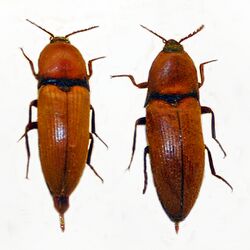Biology:Elater ferrugineus
| Elater ferrugineus | |
|---|---|

| |
| Elater ferrugineus | |
| Scientific classification | |
| Kingdom: | |
| Phylum: | |
| Class: | |
| Order: | |
| Family: | |
| Genus: | |
| Species: | E. ferrugineus
|
| Binomial name | |
| Elater ferrugineus Linnaeus, 1758
| |
| Synonyms | |
| |
Elater ferrugineus, the rusty click beetle, is a species of click beetle belonging to the family Elateridae.
Varietas
Varietas include:[1]
- Elater ferrugineus var. morio Schilsky, 1888
- Elater ferrugineus var. occitanicus de Villers, 1789
Distribution
This species is widespread in the Western Palearctic realm.[2][3]
Description
Elater ferrugineus can reach a length of 17–24 millimetres (0.67–0.94 in).[2][4] This species is rather variable. Head is dark brown. Pronotum and elytra of males are usually bright orange or reddish, while females show a uniform dark brown color and are smaller than males. The legs are black. The antennae are mid-brown to black. In males they extend up to the posterior edge of the pronotum, while in females they are shorter.[4]
Biology
Larvae develop in hole of ancient trees of various species, mainly oak (Quercus robur),[5] ash (Fraxinus excelsior), beech (Fagus sylvatica) and elm (Ulmus spp.). The life cycle lasts 4–6 years.[6] Pupation occurs in spring.[4] These larvae are predatory. They especially prey on hermit beetle (Osmoderma eremita) and rose chafer (Cetonia aurata).[1]
When male E. ferrugineus are attracted to a female, they release compounds that attract other males to the site. These compounds include geranyl, nerylacetone and 6-methyl-5-heptene-2-one. Attraction of males only occurs in the presence of females, ensuring increased mating opportunities.[7]
References
| Wikimedia Commons has media related to Elater ferrugineus. |
- ↑ 1.0 1.1 Biolib
- ↑ 2.0 2.1 Elateridae - Click Beetles of the Palearctic Region
- ↑ Fauna europaea
- ↑ 4.0 4.1 4.2 Elateridae of the British Isles
- ↑ Ranius, Thomas (2011). "Predicting spatial occurrence of beetles and pseudoscorpions in hollow oaks in southeastern Sweden". Biodiversity and Conservation 20 (9): 2027–2040. doi:10.1007/s10531-011-0072-6. https://pub.epsilon.slu.se/11011/1/ranius_t_140304.pdf.
- ↑ Meržijevskis, Aleksandras; Tamutis, Vytautas (23 July 2012). "Elater ferrugineus Linnaeus, 1758 (Coleoptera: Elateridae) – a new species for Lithuania". Acta Zoologica Lituanica 20 (4): 242–245. doi:10.2478/v10043-010-0036-1. https://www.academia.edu/10123658.
- ↑ Harvey, Deborah J.; Harvey, Hannah; Harvey, Rachael P.; Kadej, Marcin; Hedenström, Erik; Gange, Alan C.; Finch, Paul; Didham, Raphael et al. (March 2017). "Use of novel attraction compounds increases monitoring success of a rare beetle, Elater Ferrugineus". Insect Conservation and Diversity 10 (2): 161–170. doi:10.1111/icad.12214.
Wikidata ☰ Q4666825 entry
 |

